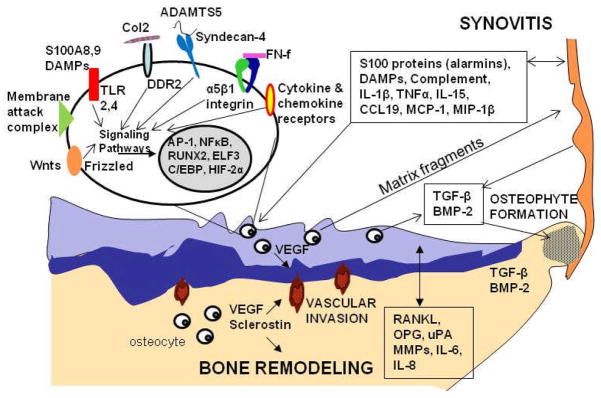Figure 3.
Selected factors involved in the osteoarthritic process in the synovium, cartilage, and bone. Proteins including S100 proteins (alarmins) and damage-associated molecular pattern molecules (DAMPs), cytokines (interleukin (IL)-1β, tumor necrosis factorα (TNFα), IL-15), chemokines (C-C motif ligand 19 (CCL19), monocyte chemotactic protein-1 (MCP-1), monocyte inflammatory protein (MIP-1β)), and complement components released from the synovium can stimulate articular chondrocytes through activation of various cell surface receptors including toll-like receptors (TLRs), cytokine and chemokine receptors, or by formation of the complement membrane attack complex. Other factors which activate cartilage matrix destruction include binding of native type II collagen to discoidin domain receptor 2 (DDR2), fibronectin fragments to the α5β1 integrin, Wnt proteins to frizzled and binding of extracellular factors to syndecan-4. Syndecan-4 may also act by targeting A Disintegrin and Metalloproteinase with Thrombospondin Motifs-5 (ADAMTS-5) to the cell surface. Various signaling pathways lead to activation of a set of transcription factors that regulate expression of matrix degrading enzymes and inflammatory mediators. Matrix fragments released from the cartilage can stimulate further synovitis. Production of vascular endothelial growth factor (VEGF) in cartilage and bone stimulates vascular invasion from subchondral bone into the zone of calcified cartilage. VEGF, sclerostin, receptor activator of nuclear factor kappa-B ligand (RANKL), osteoprotegerin (OPG), urokinase-type plasminogen activator (uPA), matrix metalloproteinase (MMP)s, IL-6 and IL-8 mediate bone remodeling and potentially diffuse to the cartilage to also promote cartilage matrix destruction. Transforming growth factor-β (TGF-β) and bone morphogenic protein-2 (BMP-2) produced in the synovium, cartilage, and bone stimulate osteophyte formation.

